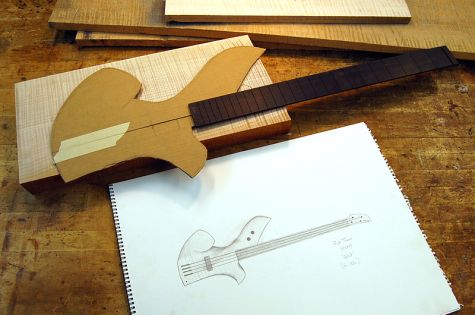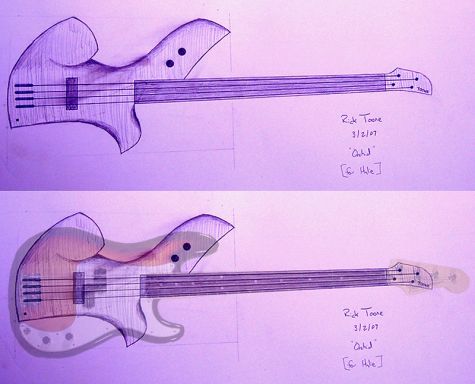Toone Guitars’ Orchid Bass
Luthier Rick Toone recently made public his Orchid bass guitar – an exciting new project I’ll be watching closely.

The customer is a woman bassist who, not surprisingly, finds the typical bass uncomfortable and unwieldy. As Rick states “Halie’s…what…5’4″ 120lbs, or so? A full-sized bass to her is like wrestling with a surfboard.”
However, this is not a scaled down bass nor a “girl guitar”. Instead, the Orchid bass maintains the standard 34″ scale while solving the ergonomic nightmare that many bass guitars represent – excessive weight and bulk combined with poor balance. These are challenges any bass player, male or female, must confront and Rick offers an alternative to instruments like the Fender P-Bass – seen in this composite view with the Orchid:

The following are some of the Orchid bass guitar’s features as noted in Rick’s article, Orchid Explained:
- Controls in the upper horn – Volume and tone controls are commonly located under the strings where they end up in the way of the strumming hand. The need to perform volume swells is typically given as a reason for placing them here but as Rick points out, most guitarists use pedals for this. Control location was something I struggled with when planning my first guitar build and I think Rick is on to something by moving them onto the horn. I suspect folks will copy this idea once they realize its wisdom.
- Balance – When I first read about the new design, I was curious about the large upper horn or lobe. According to Rick, it improves the instrument’s balance and results in the bass being located in a more centered position on the player.
- Sitting position – From a standing position to a sitting position, the Orchid “bass maintains alignment with the player’s body. The player’s thigh holds the weight, instead of the shoulder strap.”
- Reduced weight – The design makes it possible to remove a great deal of weight while maintaining its balance. Rick can even build it as a semi-hollow bass and retain its balance.
Finally, did I mention Rick is also making a guitar version of this bass design?
I have to admit, I’m not seeing the ergonomic benefits. The would-be weight reduction is surely going to be regained with that carved armrest area? And the huge horn could be further reduced, which would help out with aesthetics as well.
Now, I personally think aesthetics can be sacrificed for truly ergonomic features– and usually when this happens, a certain attractiveness is born anyhow. I like the look of the Klein, for example.
But in this case I’m not 100% convinced that ergonomic issues have been addressed; yet, the aesthetics have also been compromised. Of course, if the customer likes the look of it, my personal view of “what looks good” is absolutely irrelevant. 😀
Greg
The proof will be in the results but I think the design still demonstrates several ergonomic elements.
For example, the horn, although subject to individual aesthetics, helps to shift the balance of the instrument to compensate for the 34″ scale. A comparable element is seen in other bass designs and even the Steinberger bass uses a metal extension for the upper strap to accomplish the same goal.
Control location, although we haven’t really discussed it before, is also a consideration in ergonomics. I’ve often debated the value of typical control placement and this gets them out of the arc of the strumming hand where they may be bumped. This particular control location may not work for everyone but its certainly an area that merits consideration.
As far as aesthetics, I like the look of the Klein as well but I’m open to other interpretations and I actually like Rick’s design. I’ve also seen prior examples of Rick’s work and his sculptural approach to contouring so I’m picturing a very organic flow to the instrument which I think will fit well with this shape.
There’ll be more to come on the design… 🙂
>Control location, although we haven’t really discussed it before, is also a
>consideration in ergonomics.
Putting the controls there also has an effect on neck torque (don’t have a feel for just how much ‘tho). Since the control hollow is now “up there” and you have a greater percent of the body weight in the base, it should feel at least a bit more stable.
I really quite like the look of the bass, mind you i’m usually one for almost anything that looks unusual as long as the design has some balance or uniformity to it. Though I would agree with GregP that the upper horn looks like it could do with some reducing or slight reshaping. The only real thing that bothers me though is the lower right where the curve almost becomes a straight line, it seems that more meat could be introduced to the curve without having to add much in the way of actual wood.
I’ll be watching this space with interest!
Welcome to the blog, Sam! I can’t speak for Rick but keep in mind that these are initial sketches so certain details may evolve as he works through it and proves out the design.
Robert, you are correct. Much like “Starfish” (Goran’s guitar) the apparent shape of my instrument designs tend to change and flow relative to your viewing angle. As I have time, I will post more photos and eventually video.
The cardboard pattern is a simple and easily modified means of fitting an instrument to a player’s body. In this instance, “Orchid” was fitted to two female models, ranging in size from 5’2″ to 5’4″ and roughly 120lbs. The pattern was tweaked with shears until it was comfortable for both women in a variety of playing positions, and did not interfere with the natural movements of their breasts…from what I’ve been told, apparently not a design consideration by most manufacturers. LOL! The cardboard also becomes useful in determining if I have enough wood, and how the grain/figure will align.
In this early phase of construction, I’ve learned it is better to template a design oversized in preparation for later sculptural shaping. And, it is beneficial to have a relatively broad flat surface for initial machining: pickups, control cavities, neck joints.
The final shape will evolve through sculptural process.
Aesthetics…it took me many years before I could appreciate Picasso. As my knowledge of art grows, so does my appreciation for his work. Tricia loves Egon Schiele, particularly his minimalist line work, but I’m not yet able to share her appreciation. She has extensive formal art training, I do not. I wonder sometimes what combination of knowledge/education (understanding), life experiences, and values are involved in the aesthetic evaluation process.
It will be interesting to see how opinions evolve as construction progresses.
Thanks for the insight on your process, Rick. I’m sure it will come in handy when I finally try my hand at an original design. 😀
If it’s being shaped to a body (or in this case, pair of bodies) that really helps cast it in a new light.
I mainly agree about the control placement, though I have to say that I’ve only rarely worried about it. Perhaps this is because I don’t tend to “strum” much on an electric (just my personal style, many people DO strum!). On a bass, there will be even LESS strumming, unless the player is the one-in-ten-thousand that actually uses a strumming motion.
Isn’t this shape going to be kind of “tippy” since it’s so much heavier on the bass side than the treble side?
Greg…the scientist/educator in me thinks if you’re interested in the topic, run with it. Grab cardboard, ruler, scissors, and string (for a shoulder strap) then experiment. Far more powerful experience than my words. Maybe you’ll discover something which will benefit all of us. Share.
If a design works as cardboard…you can be certain it will work as an instrument.
PS: Hint. Modeling clay mimics mass relationships quite nicely.
I can see myself now hunched over a table full of cardboard shapes, trimmings everywhere and my wife in the background just shaking her head. 🙂
I can see that too.;)
Heh. Mad luthiers at work.
Stand back.
I don’t get it. It looks like he’s just redistributing the mass to me. Still, if it’s what the customer wants…
Redistributing the remaining mass is part of the goal in order to get the instrument to balance better. A long upper horn appears on other bass designs for the same reason while the less conventional Steinberger uses a strap extension to accomplish the same goal.
The design is obviously in its early stages but I think its on the right track.
BTW – Good to see you GL. 🙂
Gosh…I didn’t know we were involved in a Comments Ratings War. I was going to contribute some slanderous remarks about the Gibson, but I’d better comment on my own post instead. Kind of like redistributing virtual mass. Hee.
Hmmm. What to write?
Well, I think I like being referred to in 3rd person all the time, as per above. Makes me feel like royalty. No, wait. More like…a ghost.
Nice trend.
Sort of. Boo!
Go, Orchid.
I have 4lb of lead attached to the lower part of the strap to hold my Fender Jazz in some sort of proper alignment (around 50 degrees from horizontal)to help optimum playing position. See Bunny Brunel (Carvin BB series) on utube for a beautiful playing position and thumb and finger placement!
I think I might soon have curvature of the spine using this lead solution, so I think your goal of balance is the right way to go no matter what aesthetics suffer. Is aesthetic consideration all the bass making companies use in their designs?
Best regards,
Kev
I really think this bass is quite beautiful.
But i was wondering why orchid for the name?
Lynnette — thanks for your compliment. The name is as simple as the shape of the body — which is highly sculpted, especially the back — combined with purple, to me seemed reminiscent of the flower: http://images.google.com/images?hl=en&um=1&sa=1&q=purple+orchid&btnG=Search+Images